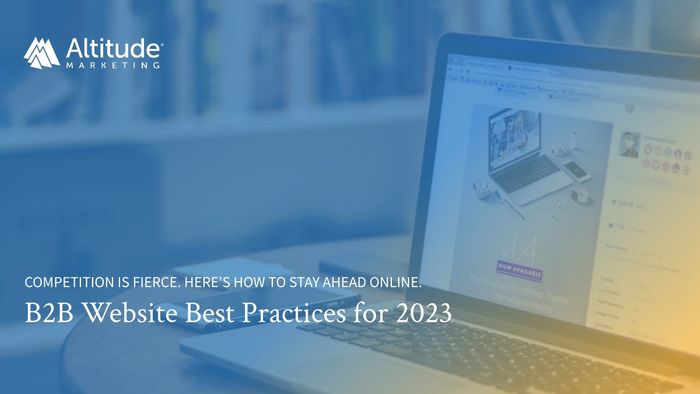In the business-to-business marketing world, competition is stiff. Even the smallest competitive advantage can mean the world. And that absolutely extends to your online presence.
We’ve produced plenty of content on B2B websites in the past. But in 2023, it’s worth going back to basics. These B2B website best practices will help ensure your digital footprint is solid. Best of all, none are highly technical – that means any marketer can implement them!
These tips and tricks are applicable to anyone, whether you’re an eCommerce website dropshipping from Alibaba, an enterprise software vendor, or anything in between.

B2B Website Best Practices for 2023
- Use clear messaging
- Make your CTAs obvious
- Focus on the user experience
- Make sure your site loads fast
- Invest in good hosting
- Don’t code from scratch
- Utilize responsive design
- Focus on accessibility
- Integrate with your CRM
- Deploy an analytics platform
B2B Web Best Practice #1: Use Clear Messaging
Your site’s purpose and credibility should be clear to any qualified user in 5 seconds or less. Wording must adhere to industry norms, and the brand’s offerings should be immediately evident.
B2B Web Best Practice #2: Make Your CTAs Obvious
The user should never have to search for “what we want them to do.” All elements of design should push them closer to a conversion – be it a form completion, a purchase or a phone call, depending on the site in question. Your calls to action mean everything – so make them meaningful.
B2B Web Best Practice #3: Focus on UX
The user should be able to easily navigate the site, finding the information or action they want in a fashion that feels effortless. This is user experience, or “UX.” It’s a critical component in everything digital marketing – and nowhere moreso than on a B2B website.
B2B Web Best Practice #4: Make Sure Your Site Loads Fast
The site should feel “fast” to use. Loading screens should be effectively non-existent, with First Contentful Paint, Largest Contentful Paint and Time to Interactive (Google-derived metrics measuring the delay before a site is usable) as low as possible.
Not sure if your site is fast? Use Lighthouse to measure it … and fix problems.
B2B Web Best Practice #5: Invest in Good Hosting
Bargain hosting can ruin the user experience of even the best-coded website. Only premium providers (such as WPEngine) should be utilized. The slight increase in cost more than pays for itself in user experience.
B2B Web Best Practice #6: Don’t Code from Scratch
Websites should never be coded from scratch in 2022. Content management systems and platforms like WordPress and Webflow eliminate a significant amount of manual work, and allow for easy maintenance in the future.
B2B Web Best Practice #7: Utilize Responsive Design
Good B2B websites must work well on any device – smartphone, tablet, laptop or desktop. “Responsive” design allows elements to dynamically adjust position to deliver a consistent UX.
B2B Web Best Practice #8: Focus on Accessibility
B-to-B websites must adhere to WCAG 2.1 guidelines for web accessibility. This not only insulates the site’s owners from nuisance (and real) lawsuits under ADA Title III, but – more critically – makes content usable for all users, regardless of disability.
accessiBe is a great tool for making your site more accessible. We use it – so should you!
B2B Web Best Practice #9: Integrate with Your CRM
Sites should be integrated with back-end systems (like CRMs), allowing for form data to pass instantly to the sales team. Integrations are sometimes native, but Zapier allows you to automate just about any data-based task.
B2B Web Best Practice #10: Deploy an Analytics Platform
Google Analytics (both the legacy Universal Analytics and the new Google Analytics 4 standard) gives site owners the ability to analyze user behavior and take advantage of opportunities. Even better, both platforms are free for the vast majority of sites.



